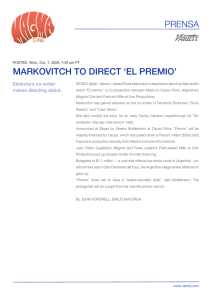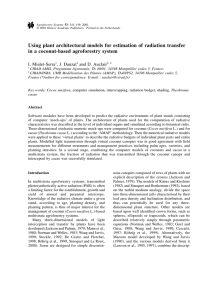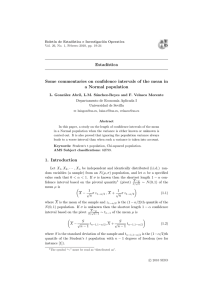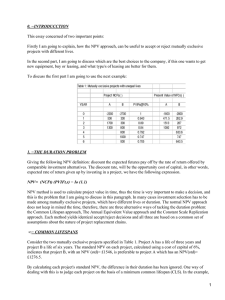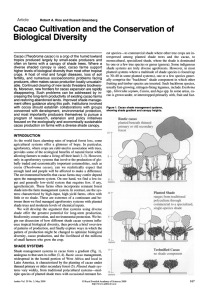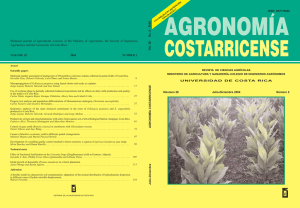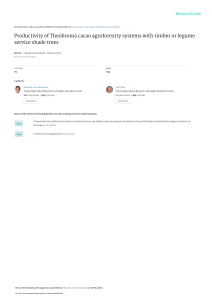Financial returns, stability and risk of cacao-plantain
Anuncio
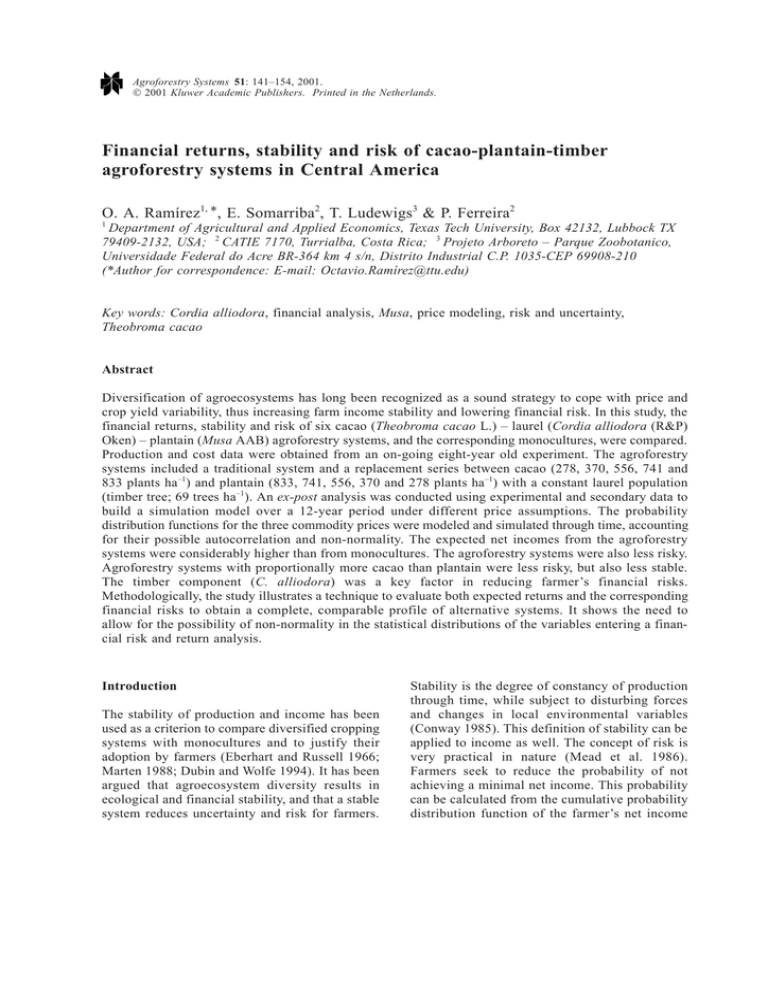
Agroforestry Systems 51: 141–154, 2001. 2001 Kluwer Academic Publishers. Printed in the Netherlands. Financial returns, stability and risk of cacao-plantain-timber agroforestry systems in Central America O. A. Ramírez1, *, E. Somarriba2, T. Ludewigs3 & P. Ferreira2 1 Department of Agricultural and Applied Economics, Texas Tech University, Box 42132, Lubbock TX 79409-2132, USA; 2 CATIE 7170, Turrialba, Costa Rica; 3 Projeto Arboreto – Parque Zoobotanico, Universidade Federal do Acre BR-364 km 4 s/n, Distrito Industrial C.P. 1035-CEP 69908-210 (*Author for correspondence: E-mail: Octavio.Ramí[email protected]) Key words: Cordia alliodora, financial analysis, Musa, price modeling, risk and uncertainty, Theobroma cacao Abstract Diversification of agroecosystems has long been recognized as a sound strategy to cope with price and crop yield variability, thus increasing farm income stability and lowering financial risk. In this study, the financial returns, stability and risk of six cacao (Theobroma cacao L.) – laurel (Cordia alliodora (R&P) Oken) – plantain (Musa AAB) agroforestry systems, and the corresponding monocultures, were compared. Production and cost data were obtained from an on-going eight-year old experiment. The agroforestry systems included a traditional system and a replacement series between cacao (278, 370, 556, 741 and 833 plants ha–1) and plantain (833, 741, 556, 370 and 278 plants ha–1) with a constant laurel population (timber tree; 69 trees ha–1). An ex-post analysis was conducted using experimental and secondary data to build a simulation model over a 12-year period under different price assumptions. The probability distribution functions for the three commodity prices were modeled and simulated through time, accounting for their possible autocorrelation and non-normality. The expected net incomes from the agroforestry systems were considerably higher than from monocultures. The agroforestry systems were also less risky. Agroforestry systems with proportionally more cacao than plantain were less risky, but also less stable. The timber component (C. alliodora) was a key factor in reducing farmer’s financial risks. Methodologically, the study illustrates a technique to evaluate both expected returns and the corresponding financial risks to obtain a complete, comparable profile of alternative systems. It shows the need to allow for the possibility of non-normality in the statistical distributions of the variables entering a financial risk and return analysis. Introduction The stability of production and income has been used as a criterion to compare diversified cropping systems with monocultures and to justify their adoption by farmers (Eberhart and Russell 1966; Marten 1988; Dubin and Wolfe 1994). It has been argued that agroecosystem diversity results in ecological and financial stability, and that a stable system reduces uncertainty and risk for farmers. Stability is the degree of constancy of production through time, while subject to disturbing forces and changes in local environmental variables (Conway 1985). This definition of stability can be applied to income as well. The concept of risk is very practical in nature (Mead et al. 1986). Farmers seek to reduce the probability of not achieving a minimal net income. This probability can be calculated from the cumulative probability distribution function of the farmer’s net income 142 (Kirby et al. 1993). A lack of correlation between the prices of the crops grown in diversified agricultural systems can decrease risk. It reduces net farm income variation and the probability of having a very low income during a given season, since low prices of one commodity are not expected to be accompanied by low prices for the other crops. The cacao (Theobroma cacao L.) – laurel (Cordia alliodora (R&P) Oken) – plantain (Musa AAB) agroforestry systems, evaluated in this study were proposed on the basis of the assumption that the prices of each commodity were not correlated (Somarriba 1994). The timber species in these systems (laurel) was envisaged as a savings account for the farmer (Platen 1996). The main objective of this study was to compare the financial returns, stability and risk of six cacao-laurel-plantain systems and of the corresponding monocultures. Cost and production data were collected between 1990–1997 (Ludewigs 1997; Somarriba et al. 1994). Prices paid to farmers were modeled and simulated accounting for autocorrelation and non-normality (Ramírez et al. 1994; Ramírez 1997; Ramírez and Somarriba 1999). The crop production and cost data was obtained from a farm in Panama, just south of the border with Costa Rica. However, cacao and plantains are produced in both countries in a homogeneous ecological area that crosses the border. The analysis was conducted for the case of Costa Rica, which is the main market for these products. Materials and methods Data sources for production values, costs and commodity prices Production and cost data were obtained from an experiment established in 1990 on a private farm in Charagre, Changuinola, Panamá (9°23′ N 82°34′ W), average annual rainfall 2,587 mm, altitude 25 m, on a Fluvaquentic Eutropept. The soil was fertile, medium textured, well drained, pH 6.0 with a water table at > 120 cm depth (Somarriba et al. 1994). Five agroforestry systems were designed by changing the proportion of cacao and plantain in a replacement series in which the proportion of each crop varied while maintaining a constant crop population (cacao plus plantain) of 1,111 plants ha–1 with cacao and plantain at 3 × 3 m (substitutive treatments). A sixth agroforestry system, with an initial one to one cacao to plantain ratio and 2,222 plants ha–1 (additive treatment) was included as a ‘farmer’s’ control (Table 1). Laurel was planted at a constant 12 × 12 m spacing (69 trees ha–1) in all six systems (Somarriba et al. 1994). The experiment had only one block (no repetition) with one 2,500 m2 plot (50 × 50 m) randomly assigned to each treatment or technology. The yield and cost data for the agroforestry systems, which has been discussed in detail elsewhere (Somarriba 1993; Somarriba et al. 1994; Calvo and Platen 1996; Platen 1996; Ludewigs 1997; Calvo and Somarriba 1998) was continuously Table 1. Cacao (Theobroma cacao), plantain (Musa AAB) and laurel (Cordia alliodora) densities in six agroforestry technologies studied in Changuinola, Panama. Planting density (plants ha–1) Technology 1cacao : 1plantain 2cacao : 1plantain 3cacao : 1plantain 1cacao : 2plantain 1cacao : 3plantain Additive treatmenta Cacao monocrop Plantain monocrop Laurel monocrop a (S1) (S2) (S3) (S4) (S5) (S6) (S7) (S8) (S9) Thinned to 910:1111:69 in year 5. Cacao Plantain Laurel Total 0,556 0,741 0,833 0,370 0,278 1,111 1,111 0,00– 0,00– 0,556 0,370 0,278 0,741 0,833 1,111 0,00– 1,111 – 00,69 0,069 0,069 0,069 0,069 0,069 0,00– 0,00– 1,111 1,181 1,181 1,181 1,181 1,181 2,291 1,111 1,111 1,111 143 collected from 1990 through 1997 (Tables 2 and 3). Secondary data on input cost and production was used for the cacao, plantain and laurel monocultures (Somarriba 1993; Platen 1996; Calvo and Somarriba 1998). International cocoa prices for the last 44 years (1954–1997) were obtained from the International Monetary Fund (IMF) statistics and transformed to real (1997) prices using the US$ Consumer Price Index reported by the IMF. Prices paid to farmers by the local cocoa marketing cooperative were US$0.12 pound–1 (dry cocoa) lower than the international price to cover the operating, marketing and transportation costs of the cooperative. Plantain price data per bunch (1 bunch = approximately 30 plantains = 16 kg) included weekly surveys of prices paid to farmers in the Talamanca region by Costa Rica’s National Production Council between 1993–1997, and monthly prices recorded from Costa Rica’s wholesale market between 1982–1997. The price series were first adjusted to real Costa Rican colones (for April, 1997) using the Consumer Price Index for the Costa Rican colon published monthly by the Ministry of Economics, Industry and Commerce (1982–1997), and then to real US$ using the April 1997 exchange rate of 1 US$ = 227.5 Costa Rican colones. Finally, a wholesale to farm-gate adjustment factor of 0.60 was calculated using the 1993–1997 portion of both data series, to be able to estimate prices paid to farmers from the modeled and simulated wholesale prices. The price series for laurel were obtained from the Costa Rican forestry chamber (1995–1997), surveys of the South-East Atlantic region of Costa Rica between 1982–1993 (H. von Platen and R. Lujan, pers. comm. 1997) and data from a milling company. The wood is normally sold ‘standing’ Table 2. Actual and projected cocoa (Theobroma cacao), laurel (Cordia alliodora), plantain (Musa AAB) yieldsa from an on-farm experiment in Changuinola, Panamá, and estimated yields for the corresponding monocultures. Cropping system Year 1990 1991 1992 1993 1994 1995 1996 1997 1998 1999 2000 2001 Monoculture yields Cocoa (kg ha–1 yr–1)b Plantain (bunches ha–1 yr–1)c Laurel (m3 ha–1 yr–1) 0000 1150 0000 0000 1150 0000 0251 1150 0000 0910 1150 0000 0898 1150 0000 906 1150 0000 0882 1150 0000 1191 1150 0000 0845 1150 0000 0973 1150 0000 0973 1150 0000 0973 1150 0105 Cocoa yields in agroforestry systems (kg ha–1 yr–1) 1cacao:1plantain 2cacao:1plantain 3cacao:1plantain 1cacao:2plantain 1cacao:3plantain Additive treatment 0000 0000 0000 0000 0000 0000 0000 0000 0000 0000 0000 0000 0128 0170 0192 0085 0064 0123 0150 0204 0225 0100 0075 0230 0217 0289 0325 0144 0108 0186 0578 0770 0866 0385 0289 0510 0756 1006 1133 0503 0378 0727 0795 1058 1191 0529 0398 0762 0801 1066 1200 0533 0400 0768 0801 1066 1200 0533 0400 0768 0801 1066 1200 0533 0400 0768 0801 1066 1200 0533 0400 0768 Plantain yields in agroforestry systems (bunches ha–1 yr–1)c 1cacao:1plantain 2cacao:1plantain 3cacao:1plantain 1cacao:2plantain 1cacao:3plantain Additive treatment 0000 0000 0000 0000 0000 0000 0000 0000 0000 0000 0000 0000 0780 0780 0780 1050 1150 1520 0950 0950 0950 1280 1420 0750 0800 0680 0600 1080 1200 0850 0780 0510 0400 1020 1150 0780 0700 0480 0380 0930 1050 0880 0770 0500 0400 1000 1120 0800 0770 0500 0400 1000 1120 0800 0770 0500 0400 1000 1120 0800 0770 0500 0400 1000 1120 0800 0770 0500 0400 1000 1120 0800 Laurel yields in agroforestry systems (m3 ha–1 yr–1) Agroforestry systems 0000 0000 0000 0000 0000 0000 0002.6 0008.8 0011.7 0019.8 0022.8 0016 a b c Farm data collected from 1990 to 1997; data projected from 1998 to 2001. Dry weights. 1 bunch = approximately 30 plantains = 16 kg. 144 Table 3. Actual and projected monocrop and agroforestry systema costs from an on-farm experiment in Charagre, Changuinola, Panamá. Cropping systemb Cacao monocrop Plantain monocrop Laurel monocrop 1cacao:1plantain 2cacao:1plantain 3cacao:1plantain 1cacao:2plantain 1cacao:3plantain Additive treatment a b Period (year) 1990 1991 1992 1993 1994 1995 1996 1997 1998 1999 2000 2001 1650 0600 0500 1978 2069 2105 1952 1831 2242 1700 0600 0400 0810 0755 0717 0891 0903 1012 0400 0600 0200 1023 1115 1193 1091 1106 1624 0350 0600 0250 1269 1317 1368 1272 1400 1893 0350 0600 0150 0869 0899 0885 0978 0902 1279 0350 0600 0125 0990 0925 0894 1051 1083 1599 0350 0600 0100 0934 0873 0844 0992 1022 1599 0350 0600 0050 0967 0914 0889 1018 1044 1599 0350 0600 0000 0967 0914 0889 1018 1044 1599 0350 0600 0000 0967 0914 0889 1018 1044 1599 0350 0600 0000 0967 0914 0889 1018 1044 1599 0350 0600 0000 0967 0914 0889 1018 1044 1599 Farm data collected from 1990 to 1997; data projected from 1998 to 2001 (costs are in US$ ha–1). Cacao (Theobroma cacao); plantain (Musa AAB), laurel (Cordia alliodora). on the farm and the buyer assumes the harvesting and transportation costs. Costa Rican prices were transformed to real US$ as for plantains (Ludewigs 1997). Price and income simulations The annual net income (NI) for each system was calculated as: NIij = Ycij × Pcj – Ccij + Ypij × Ppj – Cpij + Ylij × Plj – Clij (1) where NIij was the annual net income per hectare (ha) from Si (Table 1; where i = 1, . . , 6 denotes each of the six previously defined agroforestry systems and i = 7, 8 and 9 denotes the cacao, plantain and laurel monocultures, respectively) in year j ( j = 1, . . . , 12); Ycij, Ypij and Ylij were the cocoa, plantain and laurel yields per ha for Si in year j (Table 2); Pcj, Ppj, and Plj were simulated real prices for cocoa, plantain and laurel timber in Costa Rica; and Ccij, Cpij and Clij were real per ha production costs for cocoa, plantain and laurel in Si during year j (Table 3). Real prices and production costs were used to eliminate the effects of currency exchange and inflation rates. Price modeling accounted for autocorrelation (because commodity prices are almost always cyclical through time) and for non-normality to incorporate the possibility of infrequent but pronounced upward spikes. The methods and procedures used for the price modeling and sim- ulation are summarized in Appendix 1 (Ramírez and Somarriba 1999). Prices were simulated 20,000 times for each year ( j = 1, . . . , 12) and commodity (c, p and l). Annual net income for each of the six agroforestry systems and the three monocultures was simulated using Equation (1), the price simulations, the observed (1990–1997) and predicted (1998–2001) yields and production costs. For example, 20,000 net income simulations for year one for Si (1cacao:1plantain) were obtained by applying the appropriate version of Equation (1) (NI11 = Yc11 × Pc1 – Cc11 + Yp11 × Pp1 – Cp11 + Yl11 × Pl1 – Cl11). The six yield and production cost data points (Yc11, Cc11, Yp11, Cp11, Yl11, Cl11) were obtained from Tables 2 and 3, and were constants for the simulation of NI11. The 20,000 different simulations of NI11 resulted from using 20,000 simulated sets of values of Pc1, Pp1 and Pl1. The process described above was repeated for years 2 to 12 to obtain a matrix with 20,000 rows and 12 columns of simulated net income values for S1. Each row represented a possible 12-year net income flow for this agroforestry system and, because of the way prices were modeled and simulated, incorporated the expected price variability, cycles and the estimated probabilities of infrequent but pronounced price spikes. The Net Present Value (NPV) of each of these 12-year net income flows was calculated using the conventional formula, and real discount rates of 4, 6, 8 and 12%. This rendered four sets of 20,000 NPV simulations for S1, one for each discount rate. Only 145 the risk due to price variability was considered by this procedure; i.e., the risks due to variations in yields and production costs, for which data was limited, were not evaluated. The former procedure was repeated for the other five agroforestry systems and for the three monocultures under analysis, resulting in 36 sets of 20,000 NPV simulations, one for each combination of the nine cropping systems and the four discount rates considered. If the models were reasonably correct, each simulation outcome represented a statistically determined possible NPV occurrence for the cropping system and discount rate in question. The collection of a large number of NPV simulation outcomes provided a statistically sound approximation of the expected relative frequency of occurrence of different NPV ranges. The 20,000 simulated NPV for each agroforestry system and discount rate were classified in incremental categories of US$200 starting from their minimum. The percentage of NPV values that fall within each of a set of categories is often graphed as a histogram, which approximates the corresponding statistical probability distribution function. This percentage estimates the probability that any particular NPV falls within a given NPV-category. The cumulative percentage estimates the probability that the NPV falls within that NPV-value category or within any lower-valued category. Therefore, it approximates the corresponding cumulative probability distribution function. Risk is defined as the probability that a required minimum family income is not attained. The annual income necessary for a typical rural family in the study zone to remain above the poverty level has been estimated at US$4,632 yr –1 (MIPPE et al. 1990). A typical family farms about 4 ha (Dirección de Estadística and Censo 1991; Somarriba 1993). Thus a required minimum (12-year) NPV of $13,896 ha–1, equivalent to $1,158 ha–1 yr–1, was used as risk criterion. For each assumed discount rate, risk levels were calculated using the cumulative distribution function of the NPV for each technology (NPVTi) to determine the probability that a given cropping system would not provide the required minimum NPV. The NPV simulations were also used to calculate the mean and the variance of the NPV probability distribution of Si for each of the cropping system technologies (NPVTi), using standard formulae. The criteria utilized to assess stability was the variance of NPVTi. Empirical distributions with a lower variance identified more stable technologies, and vice versa. Results Price modeling, predictions and simulations Cocoa prices have decreased, in real terms, at an average rate of $0.0128 pound–1 yr–1 between 1954–1997 (Figure 1). They were autocorrelated, kurtotic and strongly right-skewed (Table 4 and Figure 2). Plantain prices have also decreased in real terms at an average rate of $0.025 bunch–1 yr–1 between 1982–1997 (Figure 3), were autocorrelated and right-skewed (Table 4), but less skewed than cocoa. Unlike cocoa and plantain, laurel prices were increasing at an estimated rate of $3.10 m–3 yr–1 (Figure 4) and, although normal, they also showed autocorrelation (Table 4). Expected NPV, stability and risk For all discount rates, the mean NPV’s were higher for the agroforestry systems than for the monocultures; the largest mean NPV’s corresponded to the 3cacao:1plantain technology, and the lowest to the laurel monoculture (Table 5). An inverse pattern was observed for risk, which was lower in technologies with larger mean NPV’s. Even under the most benign discount rate of 4%, which penalized future net income the least, monocrops showed risk levels in excess of 75%. The agroforestry systems (with the exception of the balanced additive treatment, which has double the population of the other agroforestry systems) presented risk levels below 22% (Table 5). Under the more demanding and realistic 8% discount rate scenario, most cropping systems exhibited risk levels of over 80%. Only the more cacao intensive agroforestry systems (3cacao:1plantain, 2cacao:1plantain and 1cacao:1plantain) presented risk levels below 80%, but above 50%, which was still high. All cropping systems showed totally unacceptable risk levels (near 90% or above) for the most demanding discount rate considered in the study (12%). 146 Figure 1. Observed and expected (predicted) international cocoa prices according to the autocorrelated non-normal model. Figure 2. Simulated frequency distribution of 1998 international cocoa prices. 147 Table 4. Parameter estimates and related statistics for the autocorrelated, non-normal cocoa (Theobroma cacao), plantain (Musa AAB) and laurel (Cordia alliodora) timber price models developed for Talamanca, Costa Rica. Parametera ρ β0 β1 σ Θ µ Cocoa prices Estimate Standard error t-value P-value 0.37630 0.07222 5.21035 00000.0 01.92833 00.31032 06.21396 00000.00 –0.01280 00.00582 02.20006 00.01689 00.57176 00.14641 03.90510 00.00018 1.16959 0.34875 3.35362 0.00089 01.61603 00.58223 02.77560 00.00421 Plantain prices Estimate Standard error t-value P-value 0.39793 0.07711 5.16039 0000.0 03.07034 00.12007 25.57136 000000.0 –0.00636 00.00324 01.96518 00.02722 01.05891 00.34471 03.07185 00.00165 0.30706 0.11463 2.67865 0.00486 21.09681 03.16228 06.67140 000000.0 Laurel prices Estimate Standard error t-value P-value 0.39657 0.13476 2.94282 0.00454 64.79763 11.34906 05.70951 00.00001 03.10354 00.84813 03.65929 00.00097 16.38008 02.67920 06.11379 00.00001 00000.0 000– 000– 000– 000000.0 0000– 0000– 0000– ρ is the autocorrelation coefficient, β0 is the model’s intercept, β1 is the model’s slope, σ is the variance of the model’s error term, and Θ and µ control the skewness and kurtosis of the dependent variable Y. a Figure 3. Observed and expected (predicted) plantain prices per bunch (1 bunch = approximately 30 plantains = 16 kg) at the Costa Rican wholesale market according to the autocorrelated non-normal model. 148 Figure 4. Observed and expected (predicted) laurel prices paid to farmers in southwest Costa Rica according to an autocorrelated but normal model. Table 5. Mean, variance ($ ha–1) of the simulated probability distributions for the net present values and risk (%) associated with three monocrop and six agroforestry systems in Talamanca, Costa Rica. Cropping system Discount rate (i) i = 4% Cacao monocropb Plantain monocrop Laurel monocrop 1cacao:1plantain 2cacao:1plantain 3cacao:1plantain 1cacao:2plantain 1cacao:3plantain Additive treatment a b i = 6% i = 8% i = 12% Mean Vara Risk Mean Vara Risk Mean Vara Risk Mean Vara Risk 12128 11301 03096 16670 18455 19267 15480 15132 12450 22.4 00.4 00.2 11.0 19.7 24.6 04.7 03.0 10.1 075.5 100.0 100.0 012.7 004.2 003.0 019.8 021.2 078.8 10494 10391 02278 14519 16083 16675 13540 13282 10796 18.5 00.4 00.1 08.4 14.7 18.0 03.7 02.4 07.6 085.9 100.0 100.0 051.4 031.0 027.2 070.2 069.3 090.3 09194 09620 01627 12687 14034 14603 11928 11698 09372 15.2 00.3 00.1 06.4 11.5 13.9 02.0 01.7 05.7 091.2 100.0 100.0 079.8 061.3 053.6 091.3 095.1 095.9 06220 08056 00225 08766 10091 10598 08464 08128 06543 10.4 00.3 00.1 03.9 07.6 08.7 00.9 01.0 02.9 100.0 100.0 100.0 100.0 093.2 089.1 100.0 100.0 100.0 Divided by 1,000. Cacao (Theobroma cacao); plantain (Musa AAB), laurel (Cordia alliodora). 149 NPV variances were larger for technologies with high mean NPV’s; i.e., the agroforestry systems were less stable than the plantain and laurel monocultures. Systems with a larger proportion of cacao to plantain were less stable. Increased discount rates gave lower mean NPV’s and NPV variances, but the risk levels of all cropping system technologies increased (Table 5). Figure 5, which is based on a 6% discount rate, can be used for a graphical illustration of how the risk levels were calculated from the simulated cumulative probability distributions for the NPV’s of each of the systems. The minimum NPV (minimum family income) required is represented by the solid vertical line (risk threshold = $13,896). The probability readings at the intersections of that vertical line with the different cumulative probability distributions (indicated by the solid horizontal lines) are the risk levels. They are the estimated probabilities that the different cropping system technologies will not provide a 12-year NPV of at least $13,896. The effect of the extreme right-skewness of cocoa prices on the cumulative probability distri- bution of the NPV of the agroforestry systems is evident in Figure 5. For technologies with a larger proportion of cacao, such as the cacao monoculture and the 3cacao:1plantain agroforestry system, the cumulative probability distribution extended far beyond the 50% risk level (i.e., the 0.50 probability point on the vertical axis). This meant that in both cases the likelihood of obtaining an NPV substantially higher than the median NPV was much greater than the likelihood of obtaining an NPV substantially lower than the median NPV. For instance, in the case of the cacao monocrop: the median NPV was approximately $9,000; the lowest possible NPV was about $5,000; but NPV’s in excess of $20,000 were still likely. The impact of this on the risk and return analysis can be understood by comparing the simulated probability distribution function of the NPV for a cacao monoculture vs. a plantain monoculture with a 6% discount rate. Although the median (50% risk-level, i.e., 0.50 probability point) NPV for the cacao monocrop was less than the minimum (near 0% risk-level) NPV for the plantain monocrop, cacao rendered a higher mean NPV (Table 5 and Figure 5. Simulated cumulative probability distributions of the net present value of income for selected cropping system technologies in Talamanca, Costa Rica, assuming a 6% real discount rate. 150 Figure 5), which made it a preferable technology for risk neutral (usually large) farmers. Discussion Cacao and plantain were two key crops in the Atlantic regions of Costa Rica and Panama. Commercial plantain monocroping was in expansion in the study regions due to favorable export market conditions but cacao areas had been declining because of both the low prices between 1987–1995, and the low yields due to the pod rot disease Moniliophthora roreri. Many traditional cacao farms have been converted to plantain (Calvo and Platen 1996). This trend, however, may change because cocoa prices have recovered significantly in recent years (Figure 1) and yields can now be substantially improved by better plantation management and the use of more productive genotypes. The price models suggested that cocoa prices were still in the midst of a low cycle and could continue to increase during the next few years to reach their expected long-term-trend value of $1.32 pound–1 in 2002 (Figure 1). After that point, however, cocoa prices were predicted to resume their declining long-term trend at a rate of $0.0128 pound–1 yr–1. Price cycles that will take cocoa prices above or below their long-term trend for several consecutive years are likely to occur again in the future, but can not be predicted with current information. Plantain prices were also cyclical. In recent years, however, they have remained very close to their projected long-term value (e.g., $2.64 bunch–1 for 1999) (Figure 3). Although a temporary upward cycle is possible, they are expected to decrease at an average rate of $0.025 bunch–1 yr–1. The short-term price environment predicted by the models, which was relatively more favorable for cocoa, suggested that the recent trend of converting cacao farms to plantain may stop or even reverse during the next few years. The long-term price environment is also expected to be more favorable for cocoa. By 2020, for example, cocoa prices are still predicted to be above their recent record low levels ($0.60–1.00 pound–1), while plantain prices are forecasted to have decreased by about 20% to $2.10 bunch –1. Substantially superior technological gains, that result in higher yields and/or production cost reductions for plantains, could offset the cocoa price advantage. However, there is no reason to expect such gains at this point. Laurel prices were also cyclical but, unlike cocoa and plantain, they were expected to increase in the short and in the long-term, at the relatively high rate of $3.10 m–3 yr–1 (Figure 4). This would imply a 50% laurel price increase by the year 2020 (from $140 to 210 m–3). The overall long-term relative price environment predicted by the models suggested that laurel could play a more important role as an agroforestry system component in the region during the next decade. Price cycles were about four times longer for cocoa than for plantain (Figures 1 and 3). Thus, agroforestry systems can help reduce the impact of prolonged periods of depressed cocoa prices on the farmers’ income while allowing them to reap superior earnings when cocoa prices are closer to their long-term trend and during any cocoa price spikes. The lack of synchronization between the price cycles supports the hypothesis of no temporal correlation between cocoa and plantain prices, which was the basis for Somarriba’s (1994) concept to reduce risk. Given the traditional definition of stability in terms of variability, it has been suggested that diversified systems are financially more stable than the corresponding monocultures. This was not the case for the agroforestry systems evaluated in this study. The variance of the NPV’s was larger for the agroforestry systems than for the plantain and laurel monocultures, because of the much higher variability of cocoa prices. Nevertheless, the NPV variance and risk levels were lower for the agroforestry systems than for the cacao monoculture. This confirmed that there were important risk and return gains that could be achieved through diversification, especially of cacao plantations. Despite their much lower stability, the agroforestry systems with a higher proportion of cacao were substantially less risky than those with a higher proportion of plantain. This finding has important implications for risk analysis. It cautions against only using stability as an indicator of the comparative risk advantage of a diversified cropping system. Even detailed expected returnvariance analyses can be misleading since they do 151 not explicitly consider how much net income variability can be tolerated by the farmer. Ramírez (1997) demonstrated that aggregate crop yields tend to be left-skewed. Market equilibrium theory suggests that this would cause a tendency for commodity prices to be right-skewed. Sudden, extreme supply shortages due to severe weather or widespread pest problems may cause sharp temporary price hikes. However, comparably large excesses in supply and the resulting extreme downward price swings are less likely, since crop yields are bound on the up-side by technological constraints (Ramírez 1997). In this study, cocoa prices turned out to be extremely skewed to the right (Figure 2). Prices of $2.00 pound–1 in excess of the median of $0.80 pound–1 were still probable in 1998, while prices of $0.40 below the medium were highly unlikely. Plantain prices were also (moderately) rightskewed, and laurel prices were normally distributed. Cacao and plantains produce throughout the year, but the supply to the market is highly affected by phenological cycles, weather and pests. Unpredictable supply from key producing areas may cause strong short-term price oscillations. Laurel, a long-term crop, is less susceptible to sporadic weather phenomena and pest attacks. Since, depending on the prevailing prices, it might be harvested any time after eight years (the growth rates in this region are extremely high (Somarriba et al. 1994)), supply and prices tended to be more stable. The extreme right-skewness of cocoa prices found in this study has several financial and economic implications. It affected the cumulative probability distribution of the NPV’s of the technologies with a higher proportion of this crop (Figure 5). In the case of the 3cacao:1plantain system, for example, 50% of the NPV’s were expected to be below and 50% above $15,000; however, NPV’s of less than $11,500 were highly unlikely while there was a 10% probability of obtaining a NPV greater that $21,000. The 1cacao:3plantain system, in contrast, had a very similar minimum likely NPV, a median NPV of $13,200, but a maximum of only $19,000. A significant proportion of the NPV variability (as measured by the variance) in the cacao intensive systems was upper variation because of the severe right-skewness of the cocoa price distribution. This does not necessarily imply more risk. For example, the mean NPV for the 1cacao:1plantain system was about 10% higher than that of the 1cacao:3plantain system, but its NPV variance was more than 300% larger. The 1cacao: 3plantain technology was likely to be preferred in standard expected return-variance analysis; however, notice that it carried more risk than 1cacao:1plantain (Table 5). A much higher NPV variability did not translate into increased risk in this case because most of it was upper variability, caused by the larger proportion of cacao in the 1cacao:1plantain system (Figure 5). This illustrates the need to allow for the possibility of non-normality in the statistical distributions of the variables entering a financial risk and return analysis. Then, both expected returns and the corresponding financial risks (applying, for example, the technique illustrated in this study) have to be evaluated to obtain a complete, comparable profile of the alternative technologies. Adequate modeling and autocorrelation simulation (i.e., the price cycles) enhances the quality and reliability of the financial risk and return analysis. Also, knowledge about the existence and expected duration of price cycles can help farm and aggregate level decision making. For example, the best time to establish or renovate a cacao plantation or agroforestry system (or to implement a policy/program that promotes cocoa production) could be five to six years after reaching the bottom of a low price cycle (about 10 years after the beginning of the cycle). Initiating long-term actions to increase production areas in the middle of a high price cycle, however, might be a mistake since, historically, the up cycles have shown to be short lived. The analysis of cocoa and plantain price right-skewness indicated that prices that are two to three times above normal should not be expected to last more than a year in the case of plantains and two to three years in the case of cocoa. Farm or policy program decisions should not be made on the assumption that the high price environment will be long lasting. On the contrary, strategies and mechanisms to defer the spending of the sharply increased farm and sector-level revenues obtained during these high price periods should be devised. At the farm level, for example, the extra revenues could be 152 invested to adopt technologies that in the long-run reduce costs, increase yields or both; i.e., technologies that will enhance profitability during average or low price periods. At the policyprogram level, for example, a revolving fund could be created that collects and invests a percentage of the extra revenues to make support payments to farmers during low price periods. The risk and return analysis showed that the agroforestry systems were a financially sound strategy to compensate for variations of the price of one crop because of unrelated and sometimes opposite changes of the price of another. For example, plantain price increases during 1984–86 and 1992–93 coincided with depressed cocoa prices, corroborating the risk reducing potential of the agroforestry systems in comparison with the cacao and plantain monocultures. These agroforestry systems rendered superior returns compared to the monocultures, with acceptable risk levels at real discount rates of 6% or less. None of the cropping system technologies evaluated provided appropriate risk protection if higher discount rates were required. Finally, it is important to mention that cacao and plantain are crops that yield continuous production throughout the year, although they show seasonality in the quantities harvested. The price fluctuations result from the supply and demand activity of the large consumption centers of Costa Rica and Panama (plantain), and of the international markets (cocoa and plantain). The latter is independent of the seasonal production patterns at the farm level. Short-term yield variations cause an uncertainty in the farmers’ monthly income, which, in the case of very small holders might be as important as the longer-term risk evaluated in this study. However, deficiencies in the data available made it impossible to also address that issue in the present study. Conclusions and recommendations Real cocoa and plantain prices showed decreasing long-term trends over time; the opposite was true for laurel timber. Substantial non-normality was detected in the case of cocoa and plantain prices, while laurel prices were normal. All price series were clearly autocorrelated. The agroforestry systems were better than the corresponding monocrops in terms of mean or expected net present value of income and risk. However, they also showed large variances and hence lower stability. Pure laurel plantations produced the lowest returns and the largest risk. Agroforestry systems with 1,111 plants ha–1 and a large proportion of cacao were preferable to those with a large proportion of plantains, since their expected NPV’s were larger and risk levels were lower. A higher density cacao-plantain mixture resulted in lower mean NPV’s and risk levels similar to those of the cacao and plantain monocrops, and hence was not recommendable. Only the agroforestry systems with an equal or higher proportion of cacao to plantain presented an acceptable risk profile under the relatively favorable condition of a low discount rate (4%). When this was increased to 6%, only 2cacao:1plantain and 3cacao:1plantain maintained an adequate risk profile and all technologies were risky at 8%. Therefore, 2cacao:1plantain and 3cacao:1plantain were the only agroforestry systems that could be recommended for a typical farmer in Bocas del Toro, Panamá. Systems with a higher proportion of cacao to plantain are favoured for the 1998–2010 period, but this is influenced by the model’s prediction of a strong rebound in cocoa prices. As future price cycles develop, a more balanced system could be preferable. The forecasted long-term decreasing trend for both cocoa and plantain prices is worrisome, especially considering the high levels of risk associated with all technologies during the 1998–2010 period. However, they are closely related to the assumption of an average farm size of 4 ha. It is clear that, in the long run, farms of that size will not be able to remain solvent unless significant technological change takes place. The upward long-term trend in the price of the wood from the tree-component (laurel) is another argument in favor of the agroforestry systems vs. the traditional cacao or plantain monocultures. Methodologically, this study illustrates a technique to evaluate both expected returns and the corresponding financial risks to obtain a complete, comparable profile of alternative agroforestry systems. It shows the need to allow for the possibility of non-normality in the statistical distribu- 153 tions of the variables entering a financial risk and return analysis. The results also caution against solely using stability as an indicator of the comparative risk advantage of a diversified cropping system. Although the financial evaluation methods presented can be applied to comparing alternative monocropping as well as multicropping systems, the risk-return trade-offs which justify this type of an analysis are more likely to occur when comparing the later. Finally, it is important to reiterate that, because of data limitations, only price variability was taken into account in this study. Cropping system yields through time were held constant at the levels observed in the experiment. This implies that the NPV variances and risk levels estimated could, in reality, be significantly higher. Both price and yield variability have to be considered for a more rigorous risk and return analysis. The techniques presented in this paper, however, can be easily modified for that purpose. Acknowledgements This research was funded by CATIE and a SUNY fellowship to the third author. The valuable comments and suggestions of John Beer, Christoph Kleinn and two anonymous reviewers are gratefully acknowledged. Appendix 1 Modeling and simulation of non-normal, autocorrelated time series of commodity prices Ramírez and Somarriba’s (1999) model, as in the case of the standard ordinary least squares regression, included a set of ‘slope’ coefficients (β) that measure the linear effect of a set of independent variables Xt on the dependent variable Y (i.e., cocoa, plantain or laurel prices), and a parameter σ (the variance of the error term). Specifically, the expected value E[Yt] and variance V[Yt] of Y are given by: E[Yt] = Xt β; µ are statistically different from zero it can be concluded that the dependent variable exhibits a kurtotic and asymmetric distribution. If µ ≠ 0, a positive σ indicates right skewness and a negative σ left skewness; as µ approaches zero, the distribution becomes symmetric, but it is still kurtotic (i.e., it has ‘fat’ tails). Ramírez and Somarriba (1999) developed the concentrated log-likelihood function that has to be maximized to obtain estimates of the formerly discussed parameters: T L = ∑ {ln(gt) + 0.5 × ln(1 – ρ2) – 0.5 × (R23t)} (2) t=1 where, if the dependent variable is autocorrelated and not normally distributed: R1 gt = [ {( ) R1 (Yt* – R2t) σ σΘ 1 + R1 = exp(0.5Θ) and 2 }] 1/2 ; exp(Θµ) – exp(–Φµ) 2 R2t = –σ + Xt*β; Yt* and Xt* are the tth elements of PY and PX; P is (txt) matrix such that (P′P)–1 = Φ, the covariance matrix for the error term that expresses the assumed autocorrelation process (Judge et al. 1985); ρ is the model’s first order autocorrelation coefficient; R3t = [ ln R and 4t + (1 + R24t)1/2 Θ R4t = ]–µ R1 * (Y – R2t). σ t Alternatively, if the dependent variable Y is normally distributed, the parameters Θ and µ will approach zero during estimation, making gt = σ–1 and R3t = (Yt* – Xt*β)/σ. Then (2) becomes the well-known normal first-order autoregressive likelihood function (Judge et al. 1985). Further, if prices are not autocorrelated, ρ will be statistically insignificant; if ρ is set to zero, maximizing (2) would yield the same results as a standard OLS regression. In other words, the model does not force non-normality or autocorrelation but it does allow for them, and their testing. Once estimates of the model’s parameters are obtained by maximizing (2), future prices can be forecasted, assuming a linear time-trending process for the expected value of cocoa, plantain and laurel prices (i.e., Xitβi = βi0 + βi1t (t = 1, . . . , T); i = 1, 2, 3), by (3): (1) V[Yt] = σ2 f (Θ, µ); where f (Θ, µ) is an exponential function of Θ and µ, the other two parameters in the model. Ramírez (1997) demonstrated that the third and fourth central moments of Yt do not depend on β or σ; i.e., they can be used to independently control its expected value E[Yt] and variance V[Yt], respectively. If Θ and YiF(T + j) = bi0 + bi1(T + j) + {ρij(Yi(T) – bi0 + bi1(T))} (3) where YiF(T + j) is the prediction of the price of the ith commodity j periods into the future, bi0 and bi1 are the estimates of the corresponding intercept and slope parameters, ρi is the autocorrelation coefficient associated to the ith commodity price, and Yi(T) is the last observed price for commodity i. Once an unbiased forecast for the expected price of commodity i, 154 that takes into account autocorrelation, is obtained using (3), simulation can be conducted following the method outlined by Ramírez and Somarriba (1999). The first step in this procedure is to generate 3 vectors vi containing 20,000 normal random variables each, with means µi and variances σi2 (i = 1, 2, 3). Then, the price distributions are simulated separately for each commodity and any future time period j using the following function: YiS(T + j) = (σi/Ri1) (eΘiVi – e–ΘiVi) + YiF(T + j) – σi 2 (4) where R1 is as specified in (1) and YiS(T + j) represents the simulated prices around the autocorrelated forecast YiF(T + j). References Calvo GD and Platen H von (1996) Cacao-laurel-plátano: costos y beneficios económicos. Serie Técnica, Informe Técnico No. 264, CATIE, Turrialba, Costa Rica Calvo GD and Somarriba E (1998) Cacao bajo sombra de leguminosas en Talamanca, Costa Rica: costos y beneficios financieros. Serie Técnica, Informe Técnico No. 301, CATIE, Turrialba, Costa Rica Conway GR (1985) Agroecosystems analysis. Agricultural Administration 20: 31–55 Dirección de Estadística y Censo (1991) Censo agropecuario de la Provincia de Bocas del Toro, Panamá – Año 1991. Contraloría General de la República de Panamá, C. Panamá, Panamá Dubin HJ and Wolfe MS (1994) Comparative behavior of three wheat cultivars and their mixture in India, Nepal and Pakistan. Field Crops Research 39: 71–93 Eberhart SA and Russell WA (1966) Stability parameters for comparing varieties. Crop Science 6: 36–41 Judge GG, Griffiths WE, Carter Hill R, Lutkepohl H and Lee TC (1985) The Theory and Practice of Econometrics, Wiley, New York Kirby MC, Sinden JA and Kaine GW (1993) Appraisal of agroforestry investment under uncertainty: a South Australian case study. Australian Forestry 56: 109–119 Ludewigs T (1997) Estabilidad y riesgo en sistemas agroforestales cacao-laurel-plátano. MSc. Thesis, CATIE, Turrialba, Costa Rica Marten GG (1988) Productivity, stability, sustainability, equitability and autonomy as properties for agroecosystems assessment. Agricultural Systems 26: 291–306 Mead R, Riley J, Dear K and Singh SP (1986) Stability comparison of intercropping and monocropping systems. Biometrics 42: 253–266 MIPPE, INRENARE, CATIE and UICN (1990) Estrategia para el desarrollo sostenible de la Provincia de Bocas del Toro, Panamá – Diagnóstico Provincial. MIPPE, Changuinola, Panamá Platen H von (1996) Alternativas de reforestación: taungya y sistemas agrosilviculturales permanentes vs. plantaciones puras: la economía. Serie Técnica, Informe Técnico No. 250, CATIE, Turrialba, Costa Rica Ramírez OA (1997) Estimation and use of a multivariate parametric model for simulating heteroscedastic, correlated, non-normal random variables: the case of corn-belt corn, soybeans and wheat yields. American Journal of Agricultural Economics 79: 191–205 Ramírez OA and Somarriba E (1999) Joint modeling and simulation of autocorrelated non-normal time-series: an application to risk and return analysis. CASNR Manuscript No. T-1-487. Texas Tech University Lubbock, USA Ramírez OA, Moss CB and Boggess WG (1994) Estimation and use of the inverse hiperbolic sine transformation to model non-normal correlates random variables. Journal of Applied Statistics 21: 289–304 Somarriba E (1993) Allocation of farm area to crops in an unstable Costa Rican agricultural community. PhD Thesis, University of Michigan, Michigan, USA Somarriba E (1994) Sistemas cacao-plátano-laurel: El concepto. Serie Técnica. Informe Técnico No. 226, CATIE, Turrialba, Costa Rica Somarriba E, Dominguez L and Lucas C (1994) Cacaoplátano-laurel: Manejo, producción agrícola y crecimiento maderable. Serie Técnica, Informe Técnico No. 233, CATIE, Turrialba, Costa Rica

